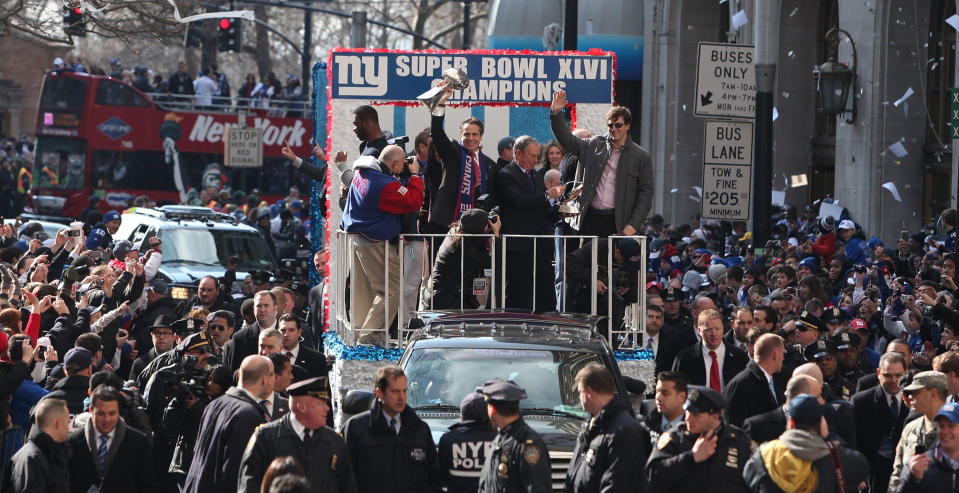Eli Manning belongs on the Giants' Mount Rushmore
On Feb. 3, 2008, Eli Manning did something no other quarterback had been able to do for the previous 18 weeks of the NFL season: He beat Tom Brady, Bill Belichick and the New England Patriots.
And he didn’t do it in some relatively meaningless game on some lazy Sunday afternoon in November. He did it on Super Bowl Sunday, a day that for a good part of the previous seven seasons, Tom and Bill had pretty much claimed as their own national holiday.
Manning and the New York Giants, with a big assist from David Tyree’s helmet, dashed the hopes of a 19-0 season for New England and preserved the legacy of the ‘72 Dolphins as the only unbeaten team in NFL history.
And four years later, Manning did it again, spoiling another Super Bowl Sunday for Brady, Belichick and an entire Patriots Nation.
The New York Giants were a wild-card team in 2007 and, with a 9-7 record, the winners of a weak NFC East in 2011, trying both times to topple a division champion considered unbeatable. Both times, the Giants were double-digit underdogs.
Both times, Eli Manning took home the MVP trophy.
[Watch live NFL games on the Yahoo Sports app, download it here]
No matter what you think about the rest of Eli Manning’s career or how hard you were rooting for the Giants to do what they did on Tuesday, benching Manning in favor of rookie Daniel Jones, those two days alone are enough to ensure a place for Manning’s head on the Giants’ Mount Rushmore, if such a thing can be carved out of the toxic landscape of the Jersey Meadowlands.
Choose any other three Giants you like — from a suggested list of Lawrence Taylor, Phil Simms, Frank Gifford, Bill Parcells and maybe Michael Strahan — but someone is going to have to move over to make room for Eli. That’s how important he has been to this franchise, and how fondly he is likely to be remembered by its fanbase.
This is a franchise that has never been known for its quarterbacks; before Simms arrived to lead the Giants out of the wasteland of Joe Pisarcik and Scott Brunner, the most memorable image of a Giants QB was the famous shot of Y.A. Tittle on his knees, blood streaming down his bald head after another crushing loss.

This was a team built on defense, linebackers mostly, that for the past three decades has played in a wind tunnel of a stadium that is a nightmare for passers. At the Meadowlands, the game plan has always been to keep the other team off the scoreboard and try to squeak out enough points to win.
But even with so little to beat, Manning is probably the greatest quarterback the Giants have ever known. Although his career record of 116-116 is a distant second to Simms’ 101-68, Simms played on defensive powerhouse teams coached by Parcells, not the likes of Pat Shurmur or his equally overmatched predecessor, Ben McAdoo.
And even allowing that today’s game is more passing-oriented than Simms’ NFL was, Manning’s stats are better in every category. He threw nearly twice as many touchdown passes (362-199), a lot fewer interceptions compared to TD passes, and nearly 13 more miles in passing yardage in only two more seasons of play. He had a better completion percentage than Simms (60 vs. 55) and his QB rating, if you’re into that sort of thing, is also higher than Simms’, 84.1 to 78.5.
Simms had a great Super Bowl himself in 1987 and deservingly won the MVP. Manning, of course, has won it twice.
But where Manning really stood out is in durability — he played in 210 consecutive games, or more than 13 straight years, before McAdoo stupidly benched him in 2017, a blunder that led to his well-deserved firing — and in doing what absolutely no one saw coming, beating the Patriots twice on the day they considered their unassailable property.
The only category in which Simms had it over Manning was in his endgame; by releasing him in the 1994 off-season, at least the Giants afforded him the courtesy of a clean break. Twice now, the Giants have botched their farewell to Manning, and there will be no room on that Mount Rushmore for its architects, Shurmur, GM Dave Gettleman or owner John Mara.
Considering what Manning did for this franchise, he deserved a whole lot better.
Had the Giants, and Manning, not won Super Bowl, Brady and Belichick would have won four of seven Supes; had he not repeated the feat in 2012, the Patriots might have rolled up a record of 7-for-7 on Super Bowl Sunday until the Eagles upset them in 2018.
Those wins were a great service for humanity, or at least that portion of humanity that does not live north of Yankee Stadium. In its own way, that first Giants win over the Patriots was even more unbelievable than the Jets upset of the Baltimore Colts in Super Bowl III.
Those Jets, at least, had Joe Namath, the prototype on which a stud quarterback is still modeled today, 50 years later. The Giants had Peyton’s little brother.
But little brother came up big both times, winning a second Super Bowl before his big brother did.
Now, 15 years after Eli Manning’s debut, the Giants are in precisely the position they were in at the start of the 2004 season — reeling, saddled with a quarterback they no longer had any confidence in, and looking for a reason to hope.
Daniel Jones gives them that hope, the same way Manning did and the same way Simms did 25 years before him. But the Giants’ Mount Rushmore is a tough hill to climb.
Eli Manning made it to the top. Time to start carving.
More from Yahoo Sports:

